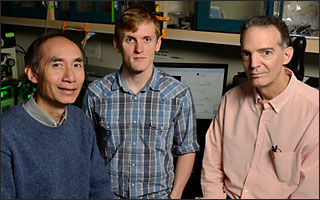A two-step defibrillator lessens pain

Often in engineering, attempts to solve one problem end up solving a different one — or, at the very least, solving the original problem in a different way than first imagined. Such is the case for Leslie Tung, PhD, and Ronald Berger, MD, PhD, two Johns Hopkins School of Medicine professors who, a few years ago, set out to create a defibrillator with less adverse effects on heart tissue.
“We developed what we thought was a promising new electrical waveform that would stop dangerous arrhythmias by producing a transient electrical block in the heart while minimizing any cardiac injury,” says Tung, of the Department of Biomedical Engineering. Although that original plan did not quite pan out, the researchers persevered and a subsequent brainstorm led to a discovery that will soon be tested in human patients.
“If you talk to patients, they often describe the experience of pain from defibrillation as ‘awful’ even though it saved their lives. Our goal became to mitigate that pain,” says Berger, of the Division of Cardiology.
The excruciating pain, it turns out, is produced not in the arrhythmic heart but throughout the skeletal muscles that also contract as they absorb the side effects of the massive electrical jolt necessary to bring the heart back into rhythm.
The secret developed by the researchers was a new type of electrical pulse consisting of a two-step pulse instead of the conventional single-step pulse used in today’s defibrillators. The first “kinder, gentler” surge, preconditions the skeletal muscles for the second larger pulse to come, causing them to contract, but not quite to the extreme they would from a full jolt.
“We found that an initial pulse in the range of 10–50 volts was sufficient to pre-condition the skeletal muscle, minimizing the subsequent response to the 500–800 volt shock that follows,” says Tung. Berger explains further, “In essence we fool the body so as to mask the ensuing shock. The muscles don’t feel the pain.”
During several years of development and testing, Tung and Berger received funding from the National Institutes of Health and the Wallace H. Coulter Foundation. Work is continuing with support from a $1 million Small Business Innovation Research grant from the NIH, and trials of the two-step defibrillator will soon begin in patients.
